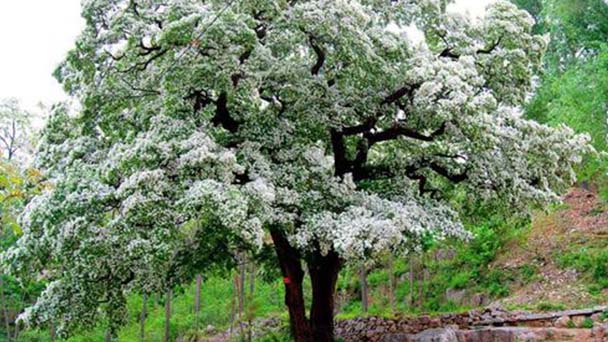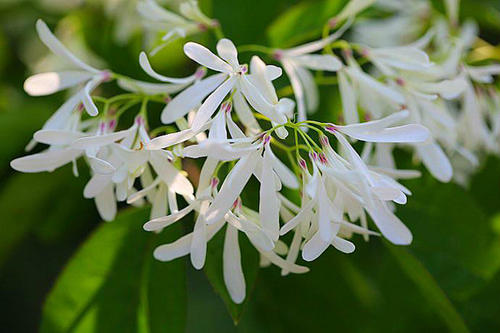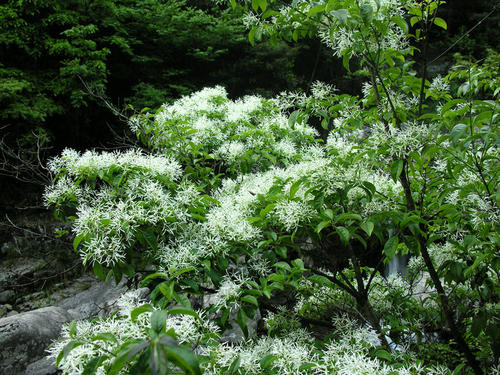Fringe tree profile
Written by Maggie
Feb 07 2021

Fringe tree is a deciduous shrub or Tree covering a Fringe Tree in the family Rhinoceros. Fringe tree is tall and graceful with luxuriant leaves. In early summer, the Tree is covered with white flowers, such as frost and snow.
Fringe tree picture

Morphological characteristics of fringe tree
Fringe trees are deciduous shrubs or trees up to 20 metres tall. Branchlets are grayish-brown or black-gray, cylindrical, spreading, glabrous, young branches pale yellow or brown, sparsely or densely pubescent.
Leaf blade of Fringe tree is leathery or heavy leather qualitative, oblong, elliptic, or rounded, sometimes ovate or obovate to ovoid lanceolate, 3-12 cm long, 2-6.5 cm wide, apex obtuse, sometimes recessed or sharp pointed, base rounded or broadly cuneate to cuneate, thin shallow heart, margin entire or have small serrated, margin slightly revolute, childhood along veins pilose above, below is dense or hydrophobic pilose, margin with eyelash, above, covered with soft hairs along veins, when old along veins densely pilose below, rare puberulous, the rest of the sparsely pilose or nearly glabrous, midrib above recess, raised below, lateral veins 3-5 pairs, the two sides slightly convex or slightly concave into the above. Veinlets of Fringe tree are often conspicuously convex on both surfaces; Petiole of Fringe tree is 0.5-2 cm long, densely yellow curly pubescent.
Inflorescences of Fringe tree are cymose panicles, 3-12 cm long, terminal at branch tips, subglabrous; Bracts of Fringe tree are linear, 2-10 mm long, sparsely or densely pubescent, flowers 1.2-2.5 cm long, unisexual and dioecious or bisexual; Pedicels of Fringe tree are 0.5-2 cm long, slender, glabrous; Calyx is 1 -- 3 mm long, 4-lobed, lobes apiculate triangular or lanceolate, 0.5 -- 2.5 mm long; Corolla is white, 4-lobed, lobes linear-oblanceolate, (1-) 1.5-2.5 cm long, 0.5-3.5 mm wide, corolla tubes short, 1.5-4 mm long; Stamens of Fringe tree are concealed in tubes or slightly protruding, filaments below 0.5 mm, anthers ovate, 1.5 -- 2 mm long, connectors protruding; Ovary is ovate, 1.5-2 mm long, stigma globose, slightly 2-lobed.
Fruit elliptic, pinkish, 1-1.5 cm long, 6-10 mm in diameter, bluish-black or black
Fringe tree growth habit
Fringe Tree like light, shade, not resistant to cold and drought tolerant, avoid water, slower growth rate, long life, resistance or poor, and the soil is relaxed, but to grow in the fertile, good permeability in silty loam best, has certain salt-tolerance, in pH8.7, salt content, 0.2% of mild saline soils can be normal growth, did not see any adverse reaction. Fringe trees like light, also more tolerant of shade. Fringe trees like warm climates, but also quite cold. Fringe trees like neutral and slightly acidic soil, drought resistant barren, not waterlogging resistance.Growing below 3000 meters above sea level in the sparse mixed forest or shrub, or hillside, river. It is cultivated everywhere.
The geographical distribution of fringe tree
Fringe tree was produced in China Gansu, Shaanxi, Shanxi, Hebei, Henan to the south of Yunnan, Sichuan, Guangdong, Fujian, Taiwan all over the cultivation.North Korea, Japan also have distribution.
Fringe tree propagation methods
Fringe trees can be propagated by sowing, cutting and grafting. Sowing and cutting are the most commonly used because they are easy to do and can produce a large number of seedlings at once.

Fringe tree growing method
Plant management
In the whole patch of fields, flood irrigation, 20,000 plants per mu; Plant spacing of 30 cm ×10 cm m; The rootstock of osmanthus can be grafted after 2 years. If they cultivate green seedlings, they can be transplanted from them year by year. Transplant and cultivate large seedlings of Fringe tree according to plant row spacing. Seedling transplantation of Fringe tree should be carried out in spring and autumn, small seedlings and medium seedlings should be transplanted with permanent soil, and large seedlings with soil balls. If in the process of planting, and in the future the use of tassel, cultivate potted seedling method in the first one are available, and is planted root, because the root system is soft, put in the grave the root tip 1 c m, then the rest of the root to turn left, turn right, by the grave pile in the soil plant, two years later the tassel seedlings basin with grafting, that a root soil is put forward, on the bend is formed the common seen at the bottom of the sweet osmanthus variety, strange form strange strong bonsai, according to the shape is different, when the plant root bending at random, but can't root damage. Fringe Tree is a fertilizer - rich Tree that should be plowed and weeded in summer to keep the soil loose. 1-year seedlings can grow to 0.8-1.2m in height with a 1cm diameter and 3-4cm in 3-year growth for greening.
Water management
Fringe Tree should be managed with more water and fertilizer during the cultivation process, especially during the first three years of planting. Planting to apply into the mature fermentation of cattle, horse manure as a base fertilizer, base fertilizer and planting soil fully mixed, and applying a nitrogen fertilizer to improve the plant growth, the end of autumn combined with pouring antifreeze water applied a leaf fertilizer or sesame residue.
Fringe trees like wet conditions. They should be wetted immediately after planting, wetted again after 5 days, wetted again after 5 days, and wetted once a month thereafter.
Trim the integer
Fringe Trees Fringe trees are commonly used in garden applications as either single-stem or multi-stem.
Go-it-alone: when they grow up to 1.5 meters high, when DongJian hydrophobic besides all the trunk of the collateral, only keep the trunk, and the trunk are short section, select and remain under the second year in a snip a growing strong trunk extension branch culture new twigs and other new branches all hydrophobic besides, qiu continue to short section of trunk extension of the branch, the third year in the spring, under the snip in choosing a growing select and remain robust, and the second year in the opposite direction from the branches of bud trunk extension branches of culture, then continue to clip, according to previous method until the height they demand. Then the trunk of Fringe tree is cut short, the next year in the cut mouth to choose three or four healthy, and evenly distributed branches as the main branch culture, the main branch long to a certain length can be cut short, and choose to leave side branches. At this point, the basic formation of arboreal tree type, after Fringe tree miscellaneous branches, pests, drooping branches, dry branches can be cut off.
Multi - dry type: in the nursery stage, 3-4 strong growing branches of Fringe tree can be selected as the trunk culture, later on in the trunk to choose a good Angle, balanced growth of branches as the main branch culture, the selection of main branches must pay attention to do not cross, to take one side. Henceforth the pruning should choose the upper branch with larger Angle to make the extension branch, undertake to its short cut. The purpose of this is twofold, one is to expand the canopy and the other is to facilitate the canopy ventilation and light.
Fringe tree pest control
Fringe-tree seedlings are the biggest pests and diseases of scarab. After the seedlings are raised, when the seedlings are grown, the roots will be bitten off. The usual control methods are to fill the roots with a solution of phoxem and add 2kg of water per acre, or spray 1000× trichon leaves to control the adult insects. In the early stage of Fringe tree larval development, 20% insecticide suspension agent 7000 times solution or 25% hyperosmotic phenoxycarb WP 300 times solution can be sprayed to kill the adult moth. The adult moth can be killed by light trap.[2]
A common disease of Fringe Tree is brown spot, a semi-known fungal infection that occurs most frequently during periods of high temperature and humidity.M ultiple small brown spots at the blade, with the development of the illness, disease spots can gradually expand together, eventually the whole leaf dry and fall off. If brown spot occurs, in addition to strengthening water and fertilizer management attention to ventilation and light, but also available 75% chlorothalonil WP 800 times liquid or 50% carbendazim WP 500 times liquid for prevention and control, once every ten days, can effectively control the disease.
The main value of fringe tree
Economic
Flowers, young leaves of Fringe tree can be dried tea, sweet taste; Fruit can be squeezed aromatic oil; Wood can be made into utensils. Young leaves of Fringe tree can be substituted for tea as a drink. The fruit of Fringe tree is rich in oil and can be pressed for industrial use. Wood of Fringe tree is strong and meticulous, and can be used to make appliances.
The botanical garden
Fringe Tree is adaptable and has a long life span. Tall and graceful adult trees with luxuriant foliage and delicate, lovely, and fragrant flowers. Fringe Tree is an excellent ornamental Tree for landscaping. It can also be planted in several clusters in the lawn; Also Fringe tree is suitable for roadside, forest edge, water side, around the building scattered planting. Fringe trees grow slowly and are pleasant in size. They can also work well as stand-alone trees for small paths. It is suitable for setting off with evergreen trees for better effect .Bonsai lovers can also carry out bonsai and make bonsai.

Latest Updated
- Benefits of Bugleweed - 7 Science-backed Health Benefits
- Bugleweed Dangers & Side Effects - Is It Poisonous?
- How to Plant Evergreen Trees - What You Should Know
- When to Plant Evergreens - Grow Guide for Evergreen Trees
- 12 Wonderful Evergreen Shrubs for Your Garden
- 12 Popular Evergreen Plants with Pictures for Beginners
- When And How To Prune A Lilac Bush Like a Pro
- How to Grow & Care for Lilac Vine (Hardenbergia Violacea)
- Japanese Lilac Tree (Syringa Reticulata) Care & Propagation Guide
- Shumard Oak Pros and Cons - What to Know
Popular Articles
- Winter maintenance of Antirrhinum Majus
- How to Grow Terminalia Mantaly Tree
- How to Grow and Care for Crossostephium Chinense
- How to grow Antirrhinum Majus in spring
- Peristeria Elata (Dove Orchid) Profile: Info & Care Guide
- Underwatered Snake Plant (Sansevieria Trifasciata) - Signs And How To Fix
- How to Care for Brazilian Jasmine Plant (Mandevilla Sanderi)
- How to Grow & Care for Graptopetalum Purple Delight in Summer
- Rosa Chinensis (China Rose): Plant Growing & Care Tips
- How to Care for Baby Sun Rose (Aptenia Cordifolia)